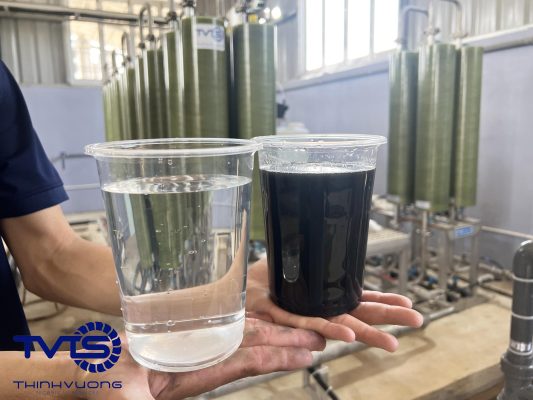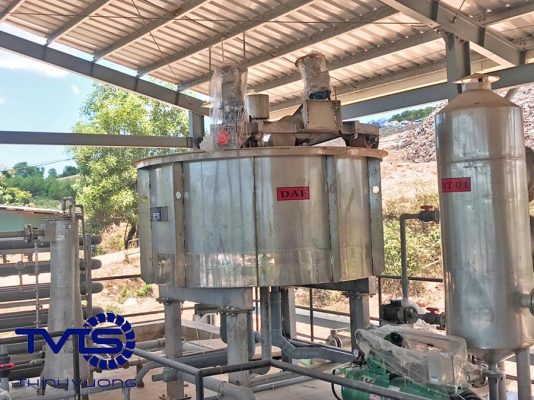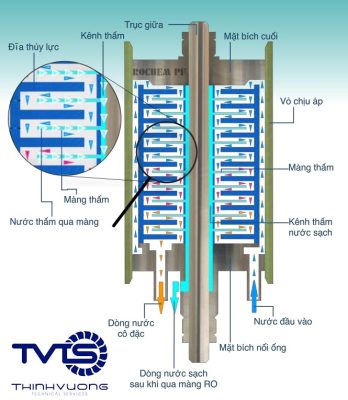Leachate is the water collected from landfills. The composition of toxic substances, heavy metals, ammonia, bacteria, and viruses is very high. To effectively treat leachate, the treatment methods must always meet the necessary requirements for water quality, long-term stability, and ease of implementation.
Currently, we are all applying common water treatment methods for leachate. The important issue lies in choosing the methods and combining them (designing the leachate treatment system) appropriately.

And in particular, choosing a reputable supplier of solutions and technology for wastewater treatment is also an important issue. Because it will help investors easily control product quality and have a place to periodically maintain and warranty the system, as well as commit to good after-sales service.
Provider of effective leachate treatment solutions
Thinh Vuong Technical Services Joint Stock Company (TVTS) has many years of experience in treating leachate for waste treatment plants in Vietnam. We are proud to be a reputable and reliable solution and technology provider for customers to choose.
By using the online search method, customers can learn more about TVTS and review reviews from previous customers. We are committed to providing good product and service quality, and always comply with warranty and after-sales service policies to meet the needs of customers.
Some popular water treatment methods currently applied in the leachate treatment process are:
Nội dung
1. Treating leachate with plants.
The method of treating leachate with plants operates based on the principle of absorbing and transforming substances by the life activities of plants. Only a few plant species are suitable for this method (for example: … ).
The process of treating leachate with plants will take place according to the following steps:
1.1 Collection of leachate:
Leachate needs to be collected to the reservoir. The collection process will take place from wastewater sources such as: landfills; landfills; garbage collection areas or industrial wastewater sources; … then to the reservoir.
Planning and development of the vegetation system: Grass system, terrestrial vegetation or water fields. The selected plants have the ability to withstand many pollutants and effectively treat water.
1.2 Pre-treatment:
Leachate from the reservoir needs to be pre-treated by physical and chemical methods. This helps reduce the concentration of substances in the leachate, making it easier for plants to receive, process and convert the substances in the leachate to levels that meet discharge standards.
After being pre-treated, the water will be led to the area where plants are available. This process will take a long time, enough for the plants to process as many toxic components as possible in the water.
Continue to treat the water through chemical processes if necessary: After the treatment process by plants, the water can be transferred to reservoirs or chemical treatment systems to remove the remaining pollutants.
Finally, reuse or safe discharge: After the treatment processes, the water can be reused for purposes that do not come into direct contact with humans or safely discharged into the environment.

1.3 Ưu điểm của phương pháp xử lý nước rỉ rác bằng thực vật:
- Sustainable and safe for nature, no use of toxic chemicals.=
- Minimize negative impacts on the environment and surrounding ecosystems.
- Provide green landscapes and create living spaces for plants and animals.
However, this method also has some limitations.
1.4 Disadvantages of the method of treating leachate with plants:
- Requires large area to build the plant system.
- Treatment time can be long and depends on environmental conditions and plant growth.
- Regular management and maintenance is required to ensure the effectiveness of the system.
- Plant diseases can develop.
Phytoremediation of leachate can be applied in areas such as landfills; waste treatment plants; industrial parks; or other areas with leachate. However, the implementation of this method needs to be carefully evaluated based on the specific conditions of each location.
A typical example of phytoremediation of leachate in Vietnam is the research project on leachate treatment at Khanh Son landfill using Vetiver grass. The results of the study showed that Vetiver grass can treat 90% of toxic substances in leachate, reduce sludge, reduce sludge, and meet the discharge standards QCVN 25:2009 BTNMT (Source: Natural Resources and Environment Newspaper).
2. Leachate treatment by coagulation method.
The flocculation method itself helps to reduce the concentration of toxic substances, chemicals, and heavy metals in leachate. The coagulation process cannot treat leachate to meet current discharge standards.
It is necessary to have knowledge and application of coagulation method along with other water treatment methods to build a leachate treatment system that meets high quality standards.
The coagulation process usually includes the following steps:
2.1 Coagulation:
Neutral colloids (aluminum sulfate (Al2(SO4)3) or poly-diamine-nitrogen (PAM)) are added to the leachate. Using a stirrer and the precipitation reaction occurs faster. The colloids will chemically react with metal components and suspended substances in the water to form precipitate products.
2.2 Flocculation:
After the precipitate product is formed, the flocculation process occurs to form large cotton particles. These cotton particles are the aggregation of solids and organic substances in the leachate.
2.3 Sedimentation:
When the cotton particles are left for a long enough time, they will settle down as sludge.
The clean water above is taken for further treatment if it does not meet the standards by using an RO ultrafiltration system, a holding tank or other methods or safely discharged. The sludge at the bottom is sent for sludge pressing or to a landfill.
Clean water must be disinfected before being used or safely discharged to destroy pathogens such as bacteria, viruses and other harmful organisms. Commonly used disinfection methods are chemical disinfection (using chlorine) or ultraviolet light (UV).

The coagulation method of leachate treatment can be applied in wastewater treatment systems, waste treatment plants, water treatment plants and other industries. The coagulation method cannot completely treat toxic substances in leachate. It needs to be designed with other methods for the best treatment efficiency.
3. Electrochemical coagulation method
The electrochemical coagulation process in leachate treatment is similar to the flocculation process. However, the process does not use, by creating an electric field environment in the water.
The electric field environment is created by an anode (positive electrode) and a cathode (negative electrode). When the electric field is created, the charged substances in the leachate are ionized and form particles with adhesive ability. They will coagulate solids, suspended matter and pollutants in the water.
The next process will be similar to the sludge separation and disinfection process as the coagulation method.
3.1 Advantages of electrochemical coagulation method
- Effectively removes secondary solids in water, such as heavy metals and organic matter.
- No need for chemical additives, reducing negative impacts on the environment.
- Capable of treating high purity water and large waste loads.
3.2 Disadvantages of electrocoagulation method
In addition, this method also has some limitations as follows:
- Requires high power and electrolysis equipment. This results in high costs and energy consumption.
- Requires careful operation and maintenance. To ensure efficiency and avoid sludge build-up on the electrodes.
4. Biological (microbiological) treatment of leachate
The biological (microbiological) wastewater treatment process in leachate treatment includes the following steps:
4.1 Separation and rough filtration:
Leachate from the reservoir is separated and rough filtered for large-sized materials (> 1mm). Then it is sent to the biological (microbiological) treatment tank.
4.2 Biological (microbiological) treatment:
During the treatment process, microorganisms are added to the leachate. These microorganisms are capable of decomposing organic matter and pollutants in their living environment.
4.3 Decomposition of organic matter:
Microorganisms decompose organic matter in leachate into harmless or less toxic substances. They can also convert organic matter into gas, dirt or solids.
4.4 Environmental control:
To ensure that the microbiological process is effective, environmental factors such as temperature; pH; and oxidation level must be controlled and maintained within the appropriate range for microorganisms.
4.5 Safe treatment or discharge:
After the microbiological process is completed. The treated water can be further treated or safely discharged into the environment.
In addition, the method of treating leachate with microorganisms has a number of advantages, including:
- Sustainability and naturalness:
Phương pháp này không sử dụng các chất hóa học độc hại. Từ đó giúp duy trì tính tự nhiên và bền vững của môi trường.
- Reduce pollution and save energy:
Compared with traditional treatment methods, biological methods help reduce pollution and save energy. At the same time, reduce negative impacts on the environment.
- Flexible application:
This method can be applied in different scales. From households to larger scales, meeting the needs of leachate treatment in different locations.
However, the biological treatment method is only suitable for leachate in old landfills, long-term landfills with long life. In the treatment of other leachate groups, the biological method will be combined with many different methods. And applied to specific leachate treatment technology processes.
5. Leachate treatment with RO membrane.
The leachate treatment system with RO membrane will include many water treatment methods. They are combined with RO membrane, such as:
- Flotation;
- Denitrification;
- Coagulation and flocculation;
- Sand filtration; Fine filtration;
- Ultrafiltration;
- UV sterilization;
- Softening;
- Remineralization;
- Ozonation; ….
RO membranes can directly treat leachate into water that meets discharge standards. However, this will damage the filter membrane, reduce its lifespan and cost a lot of operating costs. This leads to ineffective investment.
Therefore, before leachate is led into the RO system, the wastewater needs to be pre-treated in the pre-treatment process.
In the pre-treatment process, large impurities such as sludge, organic matter, suspended solids and dissolved compounds are removed.
Then, leachate is fed into the RO membrane system under high pressure. The RO membrane has a special structure with small holes, allowing only water to pass through the membrane while pollutants and impurities are blocked and removed.
Clean water after the RO process is discharged or used for suitable purposes. Or continue through the next treatment steps if necessary.
5.1 Advantages of leachate treatment with RO membrane:
- Effectively removes contaminants, bacteria, salts, heavy metals and organic substances from water.
- Provides clean and pure water, suitable for reuse or safe discharge.
- Flexibility in adjusting the treatment level and performance of the RO system.
5.2 Disadvantages of using RO membrane to treat leachate:
Using RO requires high pressure to push water through the membrane. Therefore, a strong pump system and membrane module system that allows high pressure are needed.
RO system creates a very high concentration of waste stream after RO. Therefore, it is necessary to have an incineration system for further treatment or return to landfill.
It depends a lot on the quality of RO membrane from the supplier. The membrane can be damaged by pollutants, microorganisms and sludge. Therefore, it is necessary to regularly check, clean and replace the membrane to ensure the performance of the system.

To be highly effective, it is necessary to have the right type of RO membrane for leachate. Meet the requirements of high membrane life, high clean water recovery, low consumption of membrane treatment chemicals, etc.
6. Summary
Spending many years researching leachate treatment solutions. TVTS has installed more than 10 leachate treatment systems in Vietnam. We are confident that we can provide effective solutions that are suitable for your factory’s needs.
Applying German SPRO membrane technology and water treatment methods. TVTS designs a reasonable treatment system for each module. The system is easy to repair and upgrade. We are confident in creating sustainable value for your factory. That value is reflected in each product we provide.

Choose TVTS as your trusted partner in leachate treatment. And we always accompany our customers to achieve the set results. From there, build success in your own work.



